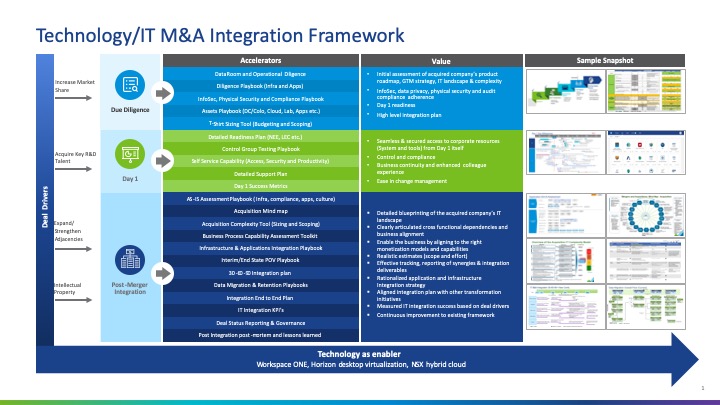by: VMware Senior Director, IT Mergers and Acquisitions Services Romy Kaura
On top of all the other massive changes, 2020 was also a rollercoaster year for mergers and acquisitions (M&A). Companies are positioning themselves for improved economic activity and to reframe their future for the post-COVID-19 pandemic era. This is driven by the need to innovate and gain greater efficiencies from the combined organizations, as well as deliver more dynamic, scalable, integrated, and efficient solutions that best empower our customers and partners to transform their businesses.
Although seamless in concept, M&A activity raises many questions for IT professionals. How do you successfully onboard new employees on Day 1 itself? Enable systems for a successful product launch and fulfillment? Integrate sales and support systems? Ensure a seamless customer experience for the combined entity? All within a matter of weeks.
The solution is to adopt a new comprehensive approach that includes a framework and technology that accomplishes the desired M&A goals—such that the unified company can hit the ground running from Day 1 and accelerate the time to market as it understands every aspect of the required operations holistically.
The right frame of mind (and technology)
This 360-degree overview is vital given a successful integration requires a thorough evaluation of the target company’s technology landscape beyond its book value. The acquirer must ascertain how the new company will complement its own IT strategy and operations, as well as which legacy processes and systems to keep or migrate. Any disruption relating to user productivity, customer experience, or business continuity—whether from a legacy application integration, network outage, or lack of access to network resources—will negatively impact the expected synergies.
The reason is that technology represents the lifeblood of the enterprise and definitely plays a central role in M&A integration. It enables key functions that encompass access, source code integration, infrastructure and network upgrades, information security, privacy and compliance, human resources (HR), finance, order management, and customer relationship management (CRM) system integrations.
Achieving a best-fit framework
Unfortunately, only employing a sequential set of activities with predetermined steps without allowing for any unexpected surprises simply does not work. IT integration needs a framework that maximizes synergies, agility, scalability, and plug and play capabilities for each phase of the deal (due diligence, Day 1, and post-merger).
So, what is a good M&A IT framework?
While every M&A is unique, there are some important considerations to keep in mind when developing a best-fit IT integration framework:
- Enterprise infrastructure and applications
- Assessment of IT infrastructure and application landscape
- Capture the current IT asset information as effectively as possible
- Identify business process, system, and cybersecurity gaps
- Assess agility and scalability needs
- Articulate business application and infrastructure integration complexity
- Examine all non-technology aspects
- Assess culture and compatibility
- Ensure business continuity, employee productivity, and better customer experience
- Mitigate legal and compliance risks
- Create well-defined goals
- Implement an operating model and governance
- Clearly articulate 30-60-90 day deliverables and beyond
- Outline interim and end-state points of view
- Measure integration KPI’s beyond milestones
- Most importantly, avoid any and all re-dos!

Better ingredients yield better results
VMware has acquired more than 25 companies in the past few years. Through that experience, our IT teams have learned an integration framework alone is not sufficient. The secret sauce is to employ proven, robust technologies that can adapt to any scenario. For our enterprise, these have included such products as VMware Workspace ONE®, VMware Horizon® desktop virtualization, VMware SD-WAN®, VMware NSX® hybrid cloud, VMware Tanzu™ (application modernization) and NSX service-defined firewalls (intrinsic security), among others.
These solutions ensure that integration complexities are addressed in a comprehensive manner. Employee productivity and business continuity are maintained. Change is effectively managed, and infrastructure, as well as applications, are integrated in the most time-efficient ways possible.
VMware on VMware blogs are written by IT subject matter experts sharing stories about our digital transformation using VMware products and services in a global production environment. Contact your sales rep or vmwonvmw@vmware.com to schedule a briefing on this topic. Visit the VMware on VMware microsite and follow us on Twitter.



